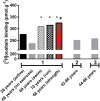Effects of Age on Na(+),K(+)-ATPase Expression in Human and Rodent Skeletal Muscle
- PMID: 27531982
- PMCID: PMC4969555
- DOI: 10.3389/fphys.2016.00316
Effects of Age on Na(+),K(+)-ATPase Expression in Human and Rodent Skeletal Muscle
Abstract
The maintenance of transmembrane Na(+) and K(+) concentration gradients and membrane potential is vital for the production of force in skeletal muscle. In aging an inability to maintain ion regulation and membrane potential would have adverse consequences on the capacity for performing repeated muscle contractions, which are critical for everyday activities and functional independence. This short review focusses on the effects of aging on one major and vital component affecting muscle Na(+) and K(+) concentrations, membrane potential and excitability in skeletal muscle, the Na(+),K(+)-ATPase (Na(+),K(+)-pump, NKA) protein. The review examines the effects of age on NKA in both human and rodent models and highlights a distant lack of research in NKA with aging. In rodents, the muscle NKA measured by [(3)H]ouabain binding site content, declines with advanced age from peak values in early life. In human skeletal muscle, however, there appears to be no age effect on [(3)H]ouabain binding site content in physically active older adults between 55 and 76 years compared to those aged between 18 and 30 years of age. Analysis of the NKA isoforms reveal differential changes with age in fiber-types in both rat and humans. The data show considerable disparities, suggesting different regulation of NKA isoforms between rodents and humans. Finally we review the importance of physical activity on NKA content in older humans. Findings suggest that physical activity levels of an individual may have a greater effect on regulating the NKA content in skeletal muscle rather than aging per se, at least up until 80 years of age.
Keywords: Na+K+-pump; [3H]ouabain; age; single fiber.
Figures


Similar articles
-
A century of exercise physiology: effects of muscle contraction and exercise on skeletal muscle Na+,K+-ATPase, Na+ and K+ ions, and on plasma K+ concentration-historical developments.Eur J Appl Physiol. 2024 Mar;124(3):681-751. doi: 10.1007/s00421-023-05335-9. Epub 2024 Jan 11. Eur J Appl Physiol. 2024. PMID: 38206444 Free PMC article. Review.
-
Unchanged [3H]ouabain binding site content but reduced Na+-K+ pump α2-protein abundance in skeletal muscle in older adults.J Appl Physiol (1985). 2012 Nov;113(10):1505-11. doi: 10.1152/japplphysiol.01032.2011. Epub 2012 Aug 30. J Appl Physiol (1985). 2012. PMID: 22936730
-
Oral digoxin effects on exercise performance, K+ regulation and skeletal muscle Na+ ,K+ -ATPase in healthy humans.J Physiol. 2022 Aug;600(16):3749-3774. doi: 10.1113/JP283017. Epub 2022 Aug 2. J Physiol. 2022. PMID: 35837833 Free PMC article. Clinical Trial.
-
Inactivity and exercise training differentially regulate abundance of Na+-K+-ATPase in human skeletal muscle.J Appl Physiol (1985). 2019 Oct 1;127(4):905-920. doi: 10.1152/japplphysiol.01076.2018. Epub 2019 Aug 1. J Appl Physiol (1985). 2019. PMID: 31369327 Review.
-
Resistance training upregulates skeletal muscle Na+, K+-ATPase content, with elevations in both α1 and α2, but not β isoforms.Eur J Appl Physiol. 2020 Aug;120(8):1777-1785. doi: 10.1007/s00421-020-04408-3. Epub 2020 Jul 3. Eur J Appl Physiol. 2020. PMID: 32500280
Cited by
-
In Vitro Cell Sensitivity to Palytoxin Correlates with High Gene Expression of the Na+/K+-ATPase β2 Subunit Isoform.Int J Mol Sci. 2020 Aug 14;21(16):5833. doi: 10.3390/ijms21165833. Int J Mol Sci. 2020. PMID: 32823835 Free PMC article.
-
Effect of Exercise and Oral Niacinamide Mononucleotide on Improving Mitochondrial Autophagy in Alzheimer's Disease.Nutrients. 2023 Jun 23;15(13):2851. doi: 10.3390/nu15132851. Nutrients. 2023. PMID: 37447179 Free PMC article. Review.
-
Overview on solubilization and lipid reconstitution of Na,K-ATPase: enzyme kinetic and biophysical characterization.Biophys Rev. 2020 Feb;12(1):49-64. doi: 10.1007/s12551-020-00616-5. Epub 2020 Jan 18. Biophys Rev. 2020. PMID: 31955383 Free PMC article. Review.
-
A century of exercise physiology: effects of muscle contraction and exercise on skeletal muscle Na+,K+-ATPase, Na+ and K+ ions, and on plasma K+ concentration-historical developments.Eur J Appl Physiol. 2024 Mar;124(3):681-751. doi: 10.1007/s00421-023-05335-9. Epub 2024 Jan 11. Eur J Appl Physiol. 2024. PMID: 38206444 Free PMC article. Review.
-
Organ reserve, excess metabolic capacity, and aging.Biogerontology. 2018 Apr;19(2):171-184. doi: 10.1007/s10522-018-9746-8. Epub 2018 Jan 15. Biogerontology. 2018. PMID: 29335816 Free PMC article. Review.
References
-
- Barrientos G., Llanos P., Hidalgo J., Bolaños P., Caputo C., Riquelme A., et al. . (2015). Cholesterol removal from adult skeletal muscle impairs excitation-contraction coupling and aging reduces caveolin-3 and alters the expression of other triadic proteins. Front. Physiol. 6:105. 10.3389/fphys.2015.00105 - DOI - PMC - PubMed
-
- Blanco G., Mercer R. W. (1998). Isozymes of the Na-K-ATPase: heterogeneity in structure, diversity in function. Am. J. Physiol. 275(5 Pt 2), F633–F650. - PubMed
Publication types
LinkOut - more resources
Full Text Sources
Other Literature Sources

